

by Holli Riebeek · design by Robert Simmon · June 28, 2005 “The perched bowlders which are found in the Alpine valleys... occupy at times positions so extraordinary that they excite in a high degree the curiosity of those who see them. For instance, when one sees an angular stone perched upon the top of an isolated pyramid, or resting in some way in a very steep locality, the first inquiry of the mind is, When and how have these stones been placed in such positions, where the least shock would seem to turn them over?“ Louis Agassiz, Etudes sur les Glaciers, 1840. |
|||
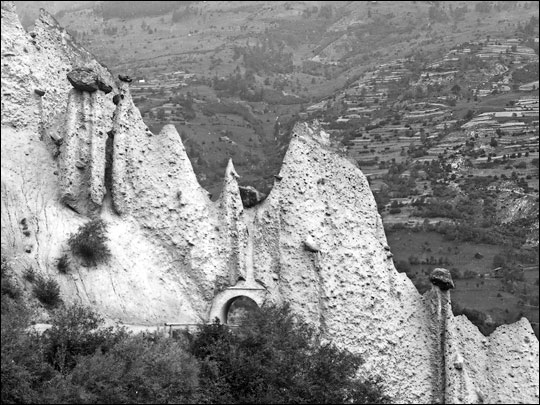 | |||
Jean-Pierre Perraudin wasn’t a scientist, but he knew that glaciers had carved out the alpine landscape around his home. He had seen the strange, giant boulders perched high in the Val de Bagnes as he hiked and hunted through the Swiss Alps near his home. Those granite rocks were different from their surroundings—they did not belong where he had seen them scattered across the valley. Perraudin had also noticed that long scratches marked the exposed rocks that lined the narrow valley. Only one thing in his experience could explain the rocks and the marks: glaciers. High in the southern portion of the valley, he had seen the large sheets of ice and the stripes they left on the land. He could picture how the ice might carry large boulders to the valley below. Perraudin concluded that glaciers must have once extended far down into the valley. Most scientists of those times considered the scratches and misplaced boulders, called erratics, firm evidence of the great Biblical flood. In Perraudin’s experience, giant rocks did not float. But when he presented his idea to naturalist Jean de Charpentier in 1815, the reception was cool. Charpentier wrote, “I found his hypothesis so extraordinary and even so extravagant that I considered it as not worth examining or even considering” (quoted in Imbrie, p 22). Despite this reception, Perraudin stood by his theory that glaciers had once extended far down into the Val de Bagnes. “I am ready to demonstrate this fact to incredulous people by the obvious proof of comparing these marks with those uncovered by glaciers at present,” he wrote defiantly (Imbrie, p. 22). He soon got his chance to prove his idea to another naturalist, Ignace Venetz, who came to the area for work. Venetz eventually convinced Charpentier that the glacier theory had merit, and he in turn converted the influential scientist Louis Agassiz. |
Balanced precariously above the road, these boulders were left behind by retreating glaciers. The boulders protected the soil underneath from erosion while the surrounding material washed away. Rocks transported by glaciers and deposited on different types of rock are called glacial erratics. (Photograph from the National Snow and Ice Data Center Glacier Photo Collection) 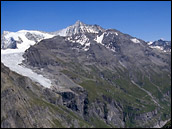
The mountains above Val de Bagnes harbor alpine glaciers, the remnants of an ice sheet that once covered much of northern Europe. (Photograph copyright Frances Perraudin) 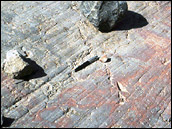
Long parallel grooves on exposed rock faces, called striations, are gouged out by rocks and debris carried on the bottom surface of a flowing glacier. Jean-Pierre Perraudin inferred that striations he saw in valleys far from existing glaciers were caused by glaciers that had since disappeared. (Photograph courtesy Richard S. Williams, Jr., U.S. Geological Survey) | ||
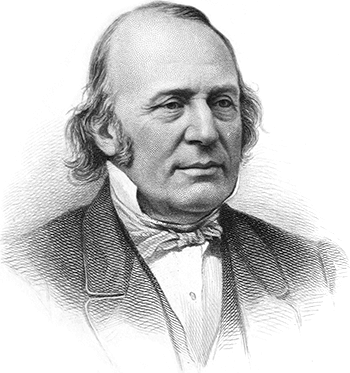
Agassiz quickly developed a broad theory of what he termed the “Ice Age,” a period in which giant glaciers extended down from the North Pole to cover Europe and much of North America. When he presented the theory on July 24, 1837, in a meeting of the Swiss Society of Natural Sciences in Neuchatel, Switzerland, he was met with sheer rage from a scientific community well-established in its views. Agassiz was undeterred. He enthusiastically showed leading scientists evidence of glaciation, and captured the public imagination with his descriptions of an icy Earth. While most scientists disagreed at first, his fervor caught the attention of the community, and by the 1870s, the Ice Age theory was widely accepted. |
Louis Agassiz (1807–1873) found evidence for a past ice age in the mountains of Switzerland. Although controversial at first, his ideas were eventually accepted by the scientific community. Modern scientists have extended his techniques, and developed many new ones, to explore past climates (both warm and cold) in detail. (Drawing courtesy History of Science Collections, University of Oklahoma Libraries.) | ||
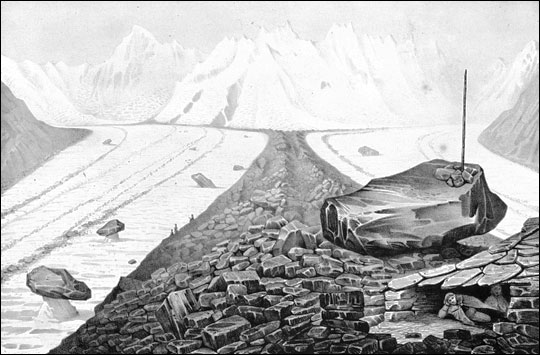
| |||
As scientists came to accept that the erratics pointed to an Ice Age, the realization triggered more questions. What had caused the Ice Age, and why had it ended? As fossils of a temperate forest were discovered sandwiched between Ice Age soil layers, scientists’ questions became increasingly more complicated. Could the Ice Ages return? Might our climate change again? Ironically, one of the theories proposed to explain what had caused the Ice Ages to come and go would become the key argument supporting an opposite, and equally controversial, kind of climate change: global warming. In 1895 Svante Arrhenius proposed that the drop in temperatures that occurred during the Ice Age could have been produced by a drop in the concentration of atmospheric carbon dioxide compared to the then-current levels. He even proposed that industrial emissions could raise Earth’s temperature in coming centuries. Despite his theory, most scientists didn’t believe that humans could affect climate until the 1960s, when evidence of human impacts on the natural world were becoming increasingly obvious. Once again, climate change became controversial, as the theory of global warming became one of the biggest scientific debates of the late twentieth century. The questions of the past generation took on a new urgency. Could climate change be a threat to humankind? And could our own actions increase the threat? These questions have compelled scientists to scour the Earth for signs of past climate change. Their search has developed into an entire scientific field: paleoclimatology, the study of past climates. In determining what has triggered climate change in the past, scientists hope to learn how natural and human triggers might change our climate in the future. Most scientists who study the past have fossils and artifacts that help them reconstruct history. But without thermometer readings, how can they know how cold it was when the ice from the last Ice Age began to retreat? Scientists who want to reconstruct past climates gather clues buried in the Earth in much the same way that an archeologist reveals past culture by looking at artifacts or a detective reconstructs a crime scene using multiple bits of evidence. |
Agassiz used detailed drawings of mountainous terrain, glacial erratics, and other glacial features to bolster his theories. The boulder in the left foreground protects the column of ice underneath it from melting, while being carried by the glacier. Eventually, the boulder will be deposited in a moraine, or left behind as an isolated erratic. [Rollover with your cursor to see overlay of features, click to see combined drawing and overlay.] (Drawings adapted from Agassiz) | ||
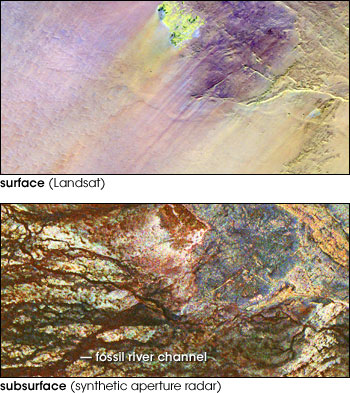
Climate leaves an imprint on the planet, in the chemical and physical structure of its oceans, life, and land. Some of these artifacts, known as climate proxies, reveal general climate patterns over the entire Earth, while other proxies reveal seasonal change in specific regions. By reading the signs of past climate, scientists reconstructed the history of Earth’s climate over hundreds of thousands—in some cases millions—of years. When combined with observations of Earth’s modern climate into computer models, paleoclimate data help scientists to predict future climate change.
|
Fossil rivers in the Sahara Desert, now buried by sand, attest to a much wetter climate in the past than now. Only a few faint stream channels are visible in the top image, a false-color scene from Landsat. Radar imagery (lower), which penetrates several meters beneath the sand, reveals a dense network of streambeds. (Images courtesy NASA/JPL imaging radar team) | ||